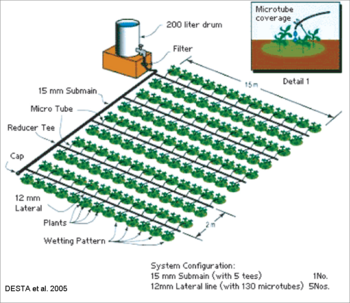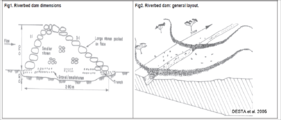Knowledge fuels change - Support energypedia!
For over 10 years, energypedia has been connecting energy experts around the world — helping them share knowledge, learn from each other, and accelerate the global energy transition.
Today, we ask for your support to keep this platform free and accessible to all.
Even a small contribution makes a big difference! If just 10–20% of our 60,000+ monthly visitors donated the equivalent of a cup of coffee — €5 — Energypedia would be fully funded for a whole year.
Is the knowledge you’ve gained through Energypedia this year worth €5 or more?
Your donation keeps the platform running, helps us create new knowledge products, and contributes directly to achieving SDG 7.
Thank you for your support, your donation, big or small, truly matters!
Micro-hydro Power (MHP) Projects - Mitigation and Intervention Techniques - Water Harvesting
Overview
► Back to the overview "Mitigation and Intervention Techniques Related to Micro-hydro Power (MHP) Projects"
Water Harvesting
Hand-dug Wells
| Objectives: Hand dug wells are used to irrigate small plots or to supply drinking water for human and livestock. |
Low Cost Water Lifting
|
Low Cost Micro-ponds
| Objectives: Supplementary irrigation to high value crops (horticulture, fruit trees, etc.). Water for livestock for a few months. Micro ponds allow to use surface runoff from small catchment areas within and between homesteads (foot paths, small grazing land areas, rocky areas, etc.). Can also collect water from feeder roads, graded bunds, spillways, etc.). Water collected can be used during the rainy season as supplementary irrigation (during dry spells) or after (1-2 months max) for additional support to horticulture crops, fruit trees, compost, small livestock, beekeeping, etc. |
Underground Cisterns
|
Percolation Pit
|
Percolation Pond
|
Farm Pond Construction
|
Spring Development
|
Family Drip Irrigation System
|
|
Roof Water Harvesting System
|
Farm Dam Construction
| Objectives: Storage farm dams are mainly to store surface runoff water and to use it when required for various uses such as for human and animal consumption, small scale or supplementary irrigation, fish production. |
River-bed or Permeable Rack Dams
| Objectives: River bed dams are a floodwater farming techniques where runoff waters are spread in valley bottoms of seasonal riverbeds, large gullies or natural water courses for improved crop and forage producdtion using a long, low structure, made from loose stone (occasionally some gabion baskets may be used). Developing gullies are healed at the same time. Occasionally it is required to raise the riverbed in order to guide spate floods into irrigation canals of spate irrigation schemes, or to accumulate river sediments for riverbed cultivation. In such a case, very strong dams are required that can resist powerful spate floods. It is a relatively low cost structure especially designed to resist heavy flooding. The structures are typically long, low dam walls across valleys. The large amount of work involved means that the technique is labor intensive and needs group approach. |
Small Stone Bunds with Run-on and Run-off Areas
| Objectives: The main objective is to considerably increase the biomass production of forage grass and legumes pastures and fodder crops and/or allow the introduction of species having higher water requirements in abandoned, marginal and eroded dry areas. The principle of the system and its application is the same as for runoff/runon systems suggested for the cultivated areas. Rainfall multiplier systems for grazing land can also rehabilitate fertility (decay of grass and increased moisture). In this respect, a few years pasture improvement and soil fertility restoration may allow the area to be cropped again. The main difference between this measure and the one described for the cultivated land is that instead of food crops fodder plants are grown. The system is less demanding in terms of size of structures and management of the plots as fodder species require less water than food crops. |
Narrow Stone Lines Along the Contour
|
Stone Faced/Soil or Stone Bunds with Run-off/ Run-on Areas
| Objectives: This is a rainfall multiplier system for reclaiming and rehabilitating marginal areas with low productivity, shallow soils, often affected by surface crusts and low water infiltration rates, with slope ranging between 1 to 5%. Both runoff and runon areas are included within the bunds. The runoff area is intended to serve as a micro catchment to supply additional water into a runon area (cultivated area) to increase production levels in one portion of the total area or to introduce crops with higher water requirements that otherwise would not grow without additional moisture. |
Conservation Bench Terraces (s) (CBT(s))
|
Tie Ridge (s)
| Objectives: Tie ridges are small rectangular series of basins formed withing the furrow of cultivated fields mainly to increase surface storage and to allow more time for rainfall to infiltrate the soil. Making tied ridges manually is time and labor consuming. |
The Zai and Planting Pit System
| Objectives: Zai pits are systems of small pits dug along approximate contours allows the cultivation of crops on degraded lands. The zaï pits restore degraded lands (crusted, hard, compacted and poorly structured soils), thus increasing the land available for cultivation. It is a simple technique that, amongst others, landless or oxless can practice because it requires only manual labour. |
Large Half Moons
| Objectives: The measure is a rainfall multiplier system that allow cultivation of crops in low rainfall areas. It is applied in areas with sandy and sandy loamy soils affected by low fertility levels and thin surface crusts that inhibit infiltration and increase runoff. Large half moons are suitable structures to enable cultivation of drought resistant crops in areas with very low rainfall. They intercept all runoff and stop erosion. It is also a measure suitable for rangelands and degraded grazing lands in dry areas (forage crops). |
Division Weir Design and Construction
|
Further Information
- Hydro Portal on energypedia
- agriwaterpedia.info - Water Harvesting
- Using Hydro Power Plants for Flood Prevention
References
DESTA, L. et al. (2005): Part 1: Community Based Participatory Watershed Development: A Guideline. Addis Ababa: Ministry of Agriculture and Rural Development.





























